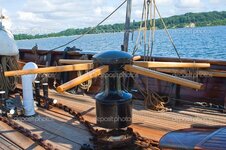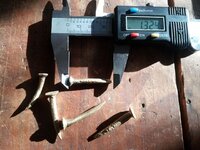FriscoT06
Hero Member
- May 2, 2011
- 600
- 650
- Detector(s) used
- Minelab Excalibur II (retired), Minelab X-Terra 505
- Primary Interest:
- Shipwrecks
Hi all,
I was in Corolla again last week, and I found what I think may be some ship's copper hull sheathing. It also appears to have two square nail holes in it. I was just wondering what you all think. From what I've read, copper sheathing was first brought to the British Royal Navy for experimenting in 1761, and was then widely outfitted on their fleet during the American Revolution. In 1832, the copper sheathing on ships began using tin and zinc added to the sheathing. If this is sheathing, do you all know how to tell if it's pre or post 1832 composition? All comments are appreciated!

I was in Corolla again last week, and I found what I think may be some ship's copper hull sheathing. It also appears to have two square nail holes in it. I was just wondering what you all think. From what I've read, copper sheathing was first brought to the British Royal Navy for experimenting in 1761, and was then widely outfitted on their fleet during the American Revolution. In 1832, the copper sheathing on ships began using tin and zinc added to the sheathing. If this is sheathing, do you all know how to tell if it's pre or post 1832 composition? All comments are appreciated!





 I say go out and get more of it an maybe you might find out where it came from.
I say go out and get more of it an maybe you might find out where it came from.








